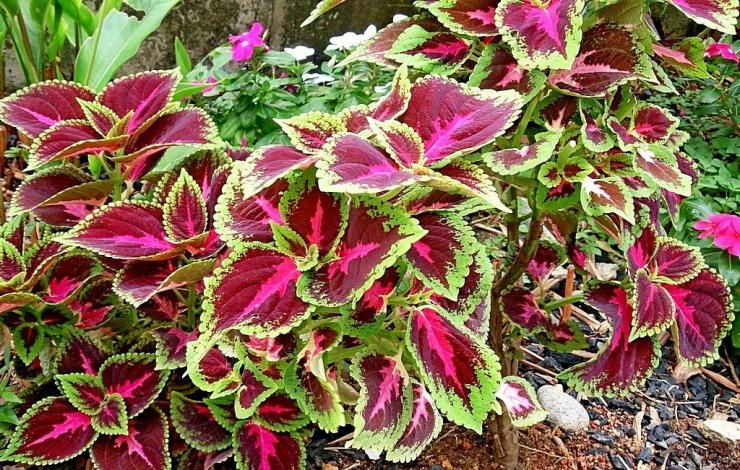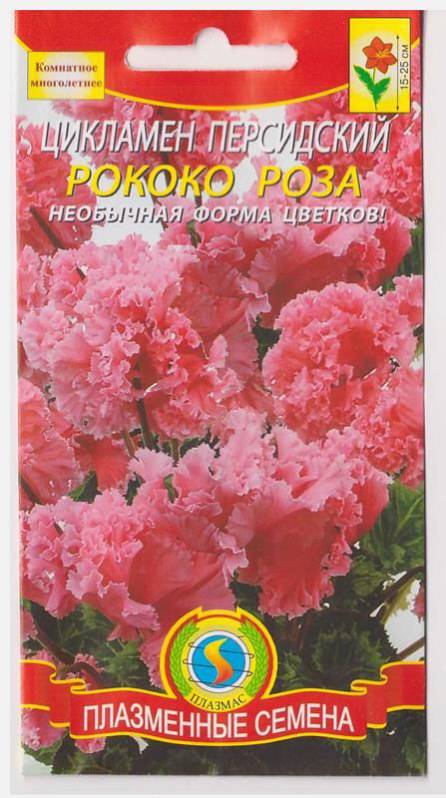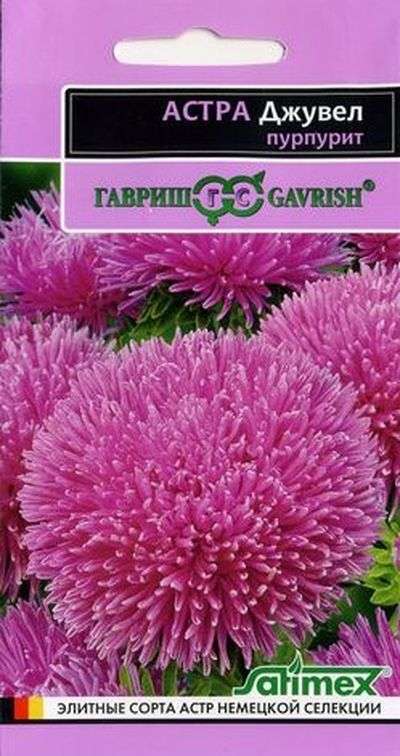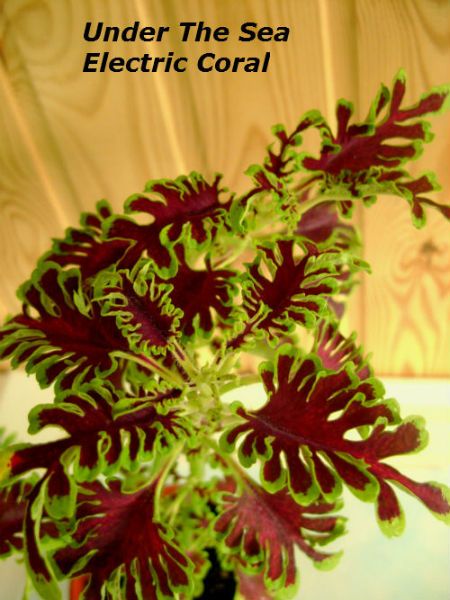Peculiarities
Coleus are plants in the form of small bushes. Its distinctive feature is lush and numerous leaves, similar in appearance to nettles. However, Coleus boasts a variety of shades of these leaves. By the way, because of the similarity, Coleus is often called "nettle" among the people.
Another name - "poor man's croton", as if hinting at the fact that the beauty and luxury of the leaves of the plant can compete with the more noble - codiaum.
Coleus is grown both as an annual and as a perennial. Despite the fact that the tropics are considered its homeland, domestic flower growers and gardeners note the unpretentiousness of the plant, the ease of caring for it. In the wild, the plant reaches 50-100 cm in height. And, although it blooms, the leaves are still considered the main decoration of the nettles. His inflorescences are small and inconspicuous.
The plant has a light-loving disposition. With a lack of light, it changes the bright color of its leaves to faded. This can be observed in the winter. However, the bright color of the leaves at the same time allows the plant to protect itself from UV rays. However, despite such persistence, it is better to shade a tropical guest in the hot summer heat.
The optimum temperature for nettles is between 20 and 25 degrees. At the same time, she is not afraid of minor temperature changes. The critical threshold for lowering the temperature is 12 degrees, the plant can die even with spring frosts. That is why the plant is planted in open ground at the end of May, when the earth and air are warmed up to 15-17 degrees.
In hot weather, Coleus requires moisture as the earthen coma dries. At the same time, the plant will tolerate a short-term drought more easily than excessive watering. Although, ideally, the earthen ball should always be slightly damp. In the summer heat, you can spray the air around the Coleus with water, avoiding moisture on the leaves. The latter should not be wiped off with a damp cloth, this can easily damage them.
Drip irrigation should be avoided. It is recommended to loosen the soil before watering and after prolonged rains. The plant is propagated by seeds or stem cuttings. Experienced gardeners usually resort to seed propagation, while the second method will be quite simple and understandable for everyone.
Caring for any variety of Coleus is almost always the same. For the successful growth and development of a plant, the following recommendations should be followed.
- When watering, it is necessary to monitor the moisture content of the upper soil layer. At high temperatures, insufficient air humidity, it is worth additionally spraying Coleus leaves.
- The temperature of the room in which the Coleus is located should not exceed 16 ° C.
- Fertilize the plant half a month after transplanting. During active reproduction, it is recommended to feed the flower every 1.5-2 weeks.
- It is necessary to prune the plant every year with the onset of the warm season. The only rule for this process is to trim the shoots up to 6-7 cm in height.
Thus, we can say that among the varieties of Coleus, everyone can find something that is pleasing to the eye. In addition to the single use of coleus, they can be combined with other plants: shade them or, conversely, play in contrast, using other flowers as a background.
See the features of sowing Coleus in different ways in the following video.
Peculiarities
Coleus are plants in the form of small bushes. Its distinctive feature is lush and numerous leaves, similar in appearance to nettles. However, Coleus boasts a variety of shades of these leaves.By the way, because of the similarity, Coleus is often called "nettle" among the people.
Another name - "poor man's croton", as if hinting at the fact that the beauty and luxury of the leaves of the plant can compete with the more noble - codiaum.
Coleus is grown both as an annual and as a perennial. Despite the fact that the tropics are considered its homeland, domestic flower growers and gardeners note the unpretentiousness of the plant, the ease of caring for it. In the wild, the plant reaches 50-100 cm in height. And, although it blooms, the leaves are still considered the main decoration of the nettles. His inflorescences are small and inconspicuous.
The plant has a light-loving disposition. With a lack of light, it changes the bright color of its leaves to faded. This can be observed in the winter. However, the bright color of the leaves at the same time allows the plant to protect itself from UV rays. However, despite such persistence, it is better to shade a tropical guest in the hot summer heat.
The optimum temperature for nettles is + 20… +25 degrees. At the same time, she is not afraid of minor temperature changes. The critical threshold for lowering the temperature is +12 degrees, the plant can die even with spring frosts. That is why the plant is planted in open ground at the end of May, when the earth and air are warmed up to 15-17 degrees.
In hot weather, Coleus requires moisture as the earthen coma dries. At the same time, the plant will tolerate a short-term drought more easily than excessive watering. Although, ideally, the earthen ball should always be slightly damp. In the summer heat, you can spray the air around the Coleus with water, avoiding moisture on the leaves. The latter should not be wiped off with a damp cloth, this can easily damage them.
Drip irrigation should be avoided. It is recommended to loosen the soil before watering and after prolonged rains. The plant is propagated by seeds or stem cuttings. Experienced gardeners usually resort to seed propagation, while the second method will be quite simple and understandable for everyone.
Coleus: breeding methods and planting features
Coleus can be propagated using cuttings during the next pruning or by seeds.
Seed propagation
Propagation seeds can be obtained from a houseplant after flowering. Seeds are sown in spring in the soil for adult coleus or for seedlings:
- Cover the ground with a film or a jar (bottle).
- The seeds do not need light for germination, but the temperature is needed within 18 ... 20 ° С.
- When 2 leaves appear, the time comes when the coleus dive.
- For watering from now on, nitrogen-based fertilizers need to be added to stimulate growth.
- The plant is transplanted into an adult pot with 6 leaves.
- Fertilize a young plant with nitrogen before the flowers appear, and then switch to mineral fertilizing. To preserve the strength of the coleus, the first flowers are immediately cut off.

Propagation by cuttings
In spring, when pruning a plant, the apical sections with 3-4 pairs of buds are selected. The lower leaves are removed from the stem, leaving only the upper ones. Cuttings are placed in clean water on the window. You can expect roots to appear in 2 weeks.
The most popular varieties (species)
Today there are many known species, varieties and varieties. The variety is full of bush, dwarf and ampelous forms.
Widespread and recognition among florists, the genus Coleus Blume received, for its aesthetic value. In appearance, it resembles a nettle with brightly colored multi-colored leaves. Plant height is not constant, but can reach 1 meter. For indoor cultivation, it is recommended to select undersized varieties. Photo:

Photo: Coleus Blume
A spectacular and unusual variety with a dark brown color. Very soft and velvety foliage.
 Photo: Dark Chocolate
Photo: Dark Chocolate
Jade Wizard
The variety is known for a white heart with a wide, bright border of green and yellow hues.If you use it in combination with Coleus of other shades, then you get a gorgeous glade of color paints on the flower bed.

Photo: Wizard
Black Dragon
It is a dwarf bush, the structure of which resembles a nettle. It is one of the few species that has a variety of almost black and very dark leaves in the family.

Photo: Black Dragon
Pomilus
The cultivar is known for its dwarf size and bright, contrasting colors. Velvet of the night
It is saturated with dark shades of reds, browns and purples with purple veins, and the shape of the leaves has a special jagged edges.

Photo: Coleus Blume
A hybrid variety, a feature of which is twisted leaves.

Photo: Fantastic
Which variety to choose
All types of coleus are good in their own way. Delightful, undemanding to growing conditions. To choose a variety, first of all, you need to understand why and where the coleus will grow. Whether it will decorate the garden or just show off on the windowsill and please the eye. For garden design, both low-growing varieties and high ones are suitable. When choosing a variety, you must trust your taste. Which coleus you like more, these should be grown.
Growing conditions and care requirements for all varieties are the same:
- In any case, whether the plant will live at home or in the garden, if it is decided to have a flower, it is advisable to purchase it in early spring.
- The plant should look healthy with lots of shoots.
- You should not buy Coleus that is getting ready to bloom. This means that it was often fed minerals due to depletion.
Varieties and types with photos
The main types of nettles include the following:
- Black dragon.
- Wizard.
- Hybrid.
- Fireway.
- Forskolia.
- Canine.
Let's consider each of them in more detail.
Black dragon
Coleus "Black Dragon" does not differ in large dimensions. It is miniature and has characteristic brightly colored velvety leaves. It is impossible to pass by such beauty. It is unpretentious in care, but with proper watering it will delight the eye for many years.
Wizard
This variety easily reaches 30 cm in height. The plant has small leaves with fluff. This group also includes Velvet Red (a bright red variety with a pink center and veins), Coral Sunrise (green, brown and pink shrubs), Jade Coleus (green plants with a yellow core).
Hybrid view
This species reaches a height of 50 to 80 cm. It has a straight, curly stem and a slight pubescence on it. The wide leaves are characterized by an ovoid shape and wavy edges. The hairs on the surface are heterogeneous, sparse. They are long and short. The color is quite diverse - it can be green, red, purple. Flowers are collected in a brush, and since there are a lot of them, they are not particularly valuable.
Fireway
The compact Coleus will be a decoration for a hanging basket, balcony box or flower bed in the garden. It is not particularly demanding on the soil, but it is better to keep it on the sunny side, ensuring watering on a schedule. If there is little light and heat, the plant will slowly begin to die.
And when there is enough of it, the bright coloration will attract a lot of attention. Small-leaved forms are planted in open ground, which have good weather resistance. They need to be cut every year to keep the plant looking healthy and effective.
Forskolia
Coleus Forskolia or tropical mint is a plant that is widely used in Indian medicine. One active ingredient activates the enzyme and adenyl cyclase. Thus, there is an effect on several systems, including the function of breaking down fat.
This type of nettles belongs to the Yasnotkov family. It has ribbed stems and opposite leaves. They can be painted green, red, burgundy and yellow. Flowers are collected in spike-shaped inflorescences.
Canine
Such a coleus is a plant that reaches 15 cm in height.It blooms in yellow or blue flowers. Most often, it combines red and green shades. It is also famous for the fact that its smell scares all cats. Therefore, if you have a cat, it is better not to have such a plant.
The use of coleus in landscape design
The regular French style of planting Coleus in the garden has been used for a long time. Since it was possible to adjust the height of the bushes, to prevent them from unattractive flowering; bright colorful foliage - all these are wonderful conditions for creating arabesque flower beds or carpet. Not a single landscape composition can do without coleus. Red coleuses look very worthy among silver cineraria, snow-white honey-fragrant alissums. Flower beds of one multi-colored "nettle" on the lawn also look great.
The richness of varieties of Coleus, a variety of colors allow you to create interesting patterns, embody the most daring ideas of landscape designers. At the same time, the plant is unpretentious, growing rapidly.
White lilies and cannes with red leaves are combined with bright coleus. Next to them, other plants feel great, since with large leaves "nettles" protect the soil and their neighbors from the burning sun's rays.
Dangling leaves of coleus warn of the need for watering.
Combinations of flowers in flowerpots, in hanging pots, which are indispensable when creating a garden design, also look elegant. Roses look gorgeous against the background of low coleuses. Low-growing varieties of flowers decorate the border, paths. Nondescript areas, empty spaces are covered with multi-colored nettles. Luxurious coleus not only delight the eye, but also cheer up.
Varieties
- ‘Golden Bedder’ - yellow leaves;
- ‘Henna’ - leaves with fringed edges;
- ‘Salmon Lace’ - red leaves with a green border;
- 'Butterfly' - wavy leaves;
- ‘Volcano’ - dark red leaves;
- ‘Saber’ - mosaic leaves with a raspberry-cherry center and light green irregular border;
- ‘Red Head’ - small fringed leaves of scarlet color;
- 'Versa Lime' - lime-colored leaves;
- 'Fishnet Stockings' - light green leaves with purple-purple veins;
- 'Salmon Pink' - Light pink center and veins with green edging.
Popular varieties:
- Mix of colors - the variety is grown as an annual. Height 50 cm. Leaves 5-7 cm long, heart-shaped, greenish-yellow, bronze and combinations with red hues.
- Fun - height 20-25 cm, a mixture of colors with a split edge.
- Wizard - height 30-35 cm, mixture of colors.
- Tenderness - height 30-35 cm, light pink center with lemon border with green splashes.
- Orange - height 15-20 cm, orange with lemon border.
- Evening dawn - height 30-35 cm, red.
- Rainbow - height 30 cm, mix, center red, border shades of green.
Series Wizard:
- Scarlet Wizard - height 30-35 cm, dark red with a light green border.
- Wizard Velvet - deep red with light teeth at the tips of the leaves.
- Wizard Golden - height 50 cm, lemon-colored leaves.
- Scarlet Wizard - brightly colored velvety leaves, scarlet in color with a lemon border.
- Wizard Sunset is a cultivar with orange leaves with light teeth at the tips of the leaves.
- Wizard Rose - height 20-25 cm, tricolor, the center of the leaf is crimson, with two edging lemon and light green.
- Wizard Mosaic - height 20-25 cm, two-color, green interspersed with burgundy.
- Wizard Golden - height 50 cm, yellow.
- Wizard Jade - yellow center with green border.
- Coral Wizard - tricolor leaves, coral middle, brown-green border.
- Magic Jade Wizard - with a white center and green border.
The most famous species and varieties of plants
The charming flowers of coleus are popularly called the "poor man's croton". They themselves come from hot Africa and the tropical forests of Asia. They are characterized by ribbed stems, lignified at the very base, as well as very attractive cordate, serrated, pubescent leaves that are a bit like nettles.The color of the foliage of these plants is simply charming, it can combine shades of maroon, green, bright red and even yellow tones. Lilac or blue flowers of Coleus are collected in small spike-shaped inflorescences. However, the cultivation of this plant is carried out exclusively because of the stunning decorative beauty of its leaves.
Fantastic Coleus, annual and perennial, today has about 150 different species.
For example, polyhybrid varieties and species have earned immense popularity in indoor floriculture. One of their parents was Coleus Blume. The height of representatives of this species is about 1 m, and its leaves have an oval shape and serrated edges. The shade of the foliage can change, depending on whether they are located in the shade or in the sun.
Coleus Renelta is also quite famous, which originates from distant Sri Lanka. The leaves of the plant are placed on tall cups, they are opposite, with wavy edges and multi-colored veins.
The most popular varieties of Coleus.
- Brilliant. Its representatives are characterized by lemon or red leaves.
- "Butterfly". The foliage of this variety has wavy edges.
- Crimson Ruffles. A fairly large variety that has a raspberry-burgundy color.
- "Buttercup". These are tall plants with a pleasant white-light green hue.
- "Candidum". The center of the leaf in such coleus is white, and the edge is pale green.
- Golden Bedder. It is characterized by yellow monochromatic leaves.
- "Firebird". A very bright and beautiful variety with corrugated foliage.
- "Rose Blush". Lush enough variety. Its large corrugated leaves have a light green edge and a pale pink center.
- "Saber". Compact coleus. Their maximum height is only 20 cm.
- "Salmon Lace". The leaves of these plants have a green-yellow edge and a red center.
- "Glory of Luxembourg". A very attractive variety. Coral streaks are scattered carelessly on its yellow leaves.
Growing coleus from seeds.
Indoor Coleus, like garden Coleus, propagates by seeds and cuttings. Reproduction of indoor coleus by seeds occurs in the same way as garden: sow seeds, and when shoots appear, they are dived into cassettes, and during the second dive, the seedling is planted in a permanent pot. Everything is simple, and almost the same as with seed reproduction of the garden coleus. And now we will tell you how to grow Coleus from a cuttings.
Growing a coleus from a cutting.
When you cut Coleus, you are left with cuts that you can use for grafting. The stalk should be about 10 cm long. You need to remove the leaves from its bottom and stick it into wet soil or sand, cover with plastic or plastic bottle and keep in the shade at a temperature of 18-20 ºC. The roots will appear in 8-10 days, and you can immediately transplant the cutting to a permanent place. This type of breeding is as simple as it is reliable.
Coleus diseases.
If you pinched or cut off a young plant at the wrong time, then its shoots can stretch out a lot. The same happens if your coleus is old or if the young plant is dark. If the light is too bright, then the color of the leaves fades, discolors. With insufficient watering, the plant loses its leaves; with waterlogging, the leaves also fall off.
Of the pests, aphids, spider mites and whiteflies are dangerous for Coleus. Aphids feed on plant sap, which makes damaged leaves turn yellow and shrivel, and are a carrier of diseases. It is simple to deal with it: you need to treat the ground parts of the indoor wheel with soapy water, and if some of the pests survive, then after a week the treatment must be repeated. Do not forget to cover the soil in the pot with a film before manipulation so that soap does not get into it. With garden coleus, such a "detailed" method is too laborious, so you will have to use insecticides. Aktellik and Fitoverm have proven themselves well in the fight against aphids. Do not take mites with soap, so we recommend Oberon, Apollo, Agravertin or Akarin.Whitefly can be destroyed with the same drugs as aphids: Aktellik, Aktara, Oberon, etc.
But the use of insecticides does not add health to plants, so as a preventive measure, follow the simple rules for caring for Coleus, and troubles such as diseases and pests will bypass you.
Home care
Caring for Coleus at home is simple and does not require much effort.
Post-purchase actions
When buying Coleus in a store, you need to follow a few simple rules:
- It is better to do it in early spring.
- Buy a plant not with a single sprouted leaf, but with a good crown;
- Do not buy a plant in blooming state;
- Examine it carefully for diseases and pests.
After purchase, you can leave it in the same pot, unless it is small for him (roots do not stick out of the drainage hole) and if it is not an imported specimen. For them, transporting soil is usually used, which is not suitable for further cultivation.
Lighting
Most Coleus are light-requiring, but direct sunlight can burn their delicate leaves. The most suitable would be the southwest or southeast side of the apartment. In hot midday hours, it is better to shade it.
In order for the crown and color of the leaves to be uniform, from time to time you need to turn the pot to the light in different directions.
In winter, he needs good light, otherwise he will be very elongated, and the leaves will fade.
Important! Plants with lighter leaf color tolerate bright light better than darker varieties.
Temperature
During active growth, the flower needs a temperature of at least 20 degrees. It will not disappear even at 12, but in winter, when it is at rest.
Watering
Coleus reacts very painfully to a lack of moisture, begins to lower the leaves and may even shed them when they dry out. In the summer, when the plant is actively growing, it must be watered as soon as the topsoil dries up. In winter, watering is done no more than 1-2 times a week.
Air humidity
High air humidity is a prerequisite for good plant development. It requires frequent spraying - up to 2 times a day in summer. You can place the pot with it in a tray with damp pebbles or put a container with it next to the flower.
The soil
Any fertile soil is suitable for Coleus, as long as it is well-drained and loose. Usually a mixture of leaf, turf and peat soil with sand is used.
Top dressing
To maintain the beauty and decorativeness of the leaves, the flower needs to be fed, especially in spring and summer.
Mineral fertilizers with potassium content are well combined with organic matter.
Nitrogen is an indispensable element of top dressing, since it is responsible for the brightness of the color of the leaves.
Coleus needs to be fed once a week when it grows and once a month in autumn and winter.
Important! In winter, the fertilizer concentration should be half as much.
Planting at home and in the garden
Planting can be done both by seeds and cuttings. It is produced in early spring. The seeds germinate quickly, and after a few months the plant pleases with its luxurious leaves.
Due to its thermophilicity, Coleus does not tolerate too low temperatures, therefore, it is necessary to plant it in the garden only after hardening and in an already warmed-up ground. The landing site should be calm and slightly protected from the direct sun by an openwork shade.
Transfer
If the Coleus is grown as a perennial plant, then it needs a transplant once every 2 years. It is done when the plant becomes cramped. You need to take a larger pot, prepare a fresh substrate and simply transfer the plant into it.
Pruning
Blooming greatly weakens the plant. Peduncles should be cut off as soon as they appear. Long shoots are also removed. In order for the plant to bush well, pinch the tops of it. Spring cardinal flower pruning is also important.
Growing from seeds
Coleus reproduces well by seeds.
Small seeds are scattered on a layer of soil and sprinkled with sand on top.
The soil must be moist.
The first shoots appear in 15-20 days and they are planted in a container at a distance of 2 cm from each other.
When 1-2 pairs of leaves appear, the sprouts dive into small pots 7 cm in diameter.
After another month, they are transferred into larger pots (9-11 cm).
Further, care for them like an adult plant.
Important! The decorative effect of new plants appears 5-6 months after planting the seeds.
Reproduction
In addition to seeds, Coleus is propagated by cuttings. They can be taken when pruning the plant at the end of February. Cuttings with the lower leaves removed are immersed in water. When roots appear, they are planted in a ready-made substrate in small pots. The temperature regime is about 18 degrees. This indoor flower is characterized by rapid growth, therefore, after 2-3 months a good crown with large leaves grows.




















































